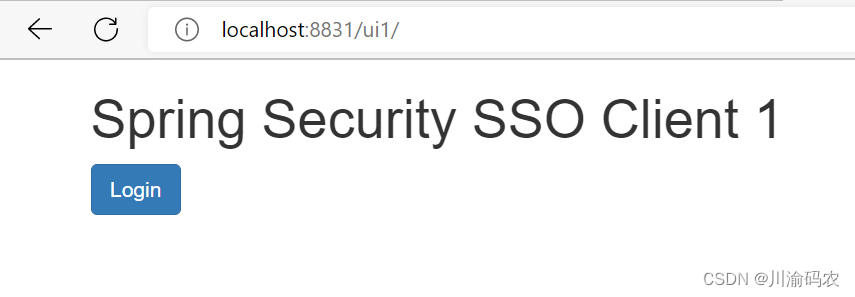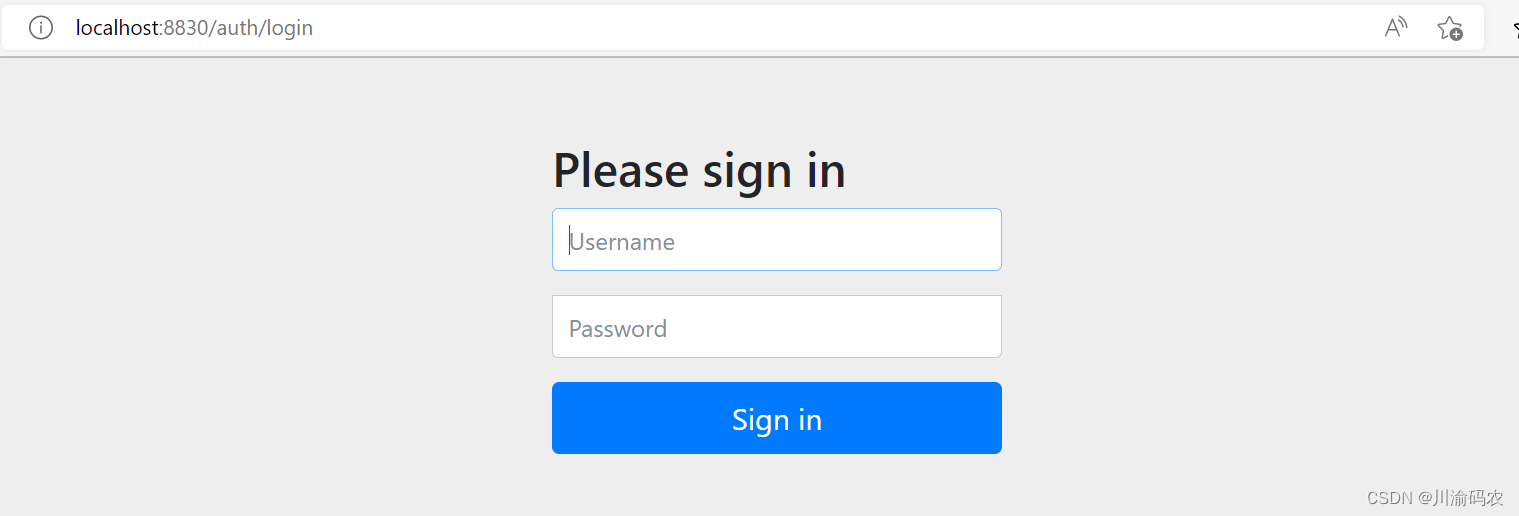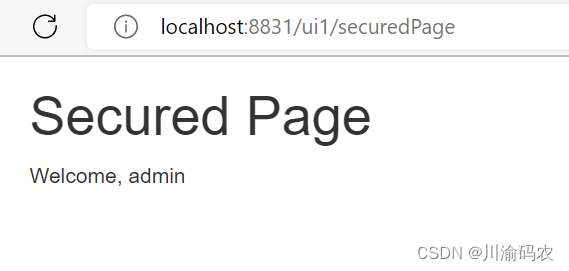SSO单点登录实现方式有多种,在这里不介绍理论,本文只讨论采用spring-security-oauth2来实现,本文共有三个服务,一个权限认证中心,两个客户端
1. 认证服务搭建
1.1. 引入核心依赖
<dependency>
<groupId>org.springframework.boot</groupId>
<artifactId>spring-boot-starter-web</artifactId>
</dependency>
<dependency>
<groupId>org.springframework.security.oauth</groupId>
<artifactId>spring-security-oauth2</artifactId>
<version>2.3.8.RELEASE</version>
</dependency>
1.2. 配置application.yml文件
server:
port: 8830
servlet:
context-path: /auth
spring:
application:
name: cloud-oss-authorization-server
1.3. 编写主启动类
@EnableResourceServer
@SpringBootApplication
public class OssAuthorizationServerApplication {
public static void main(String[] args) {
SpringApplication.run(OssAuthorizationServerApplication.class, args);
}
}
可以将Authorization Server和Resource Server放在同一个服务里
1.4. 编写SecurityConfig配置类
@Order(1)
@Configuration
public class SecurityConfig extends WebSecurityConfigurerAdapter {
@Override
protected void configure(AuthenticationManagerBuilder auth) throws Exception {
auth.inMemoryAuthentication()
.withUser("admin")
.password(passwordEncoder().encode("123456"))
.roles("USER");
}
@Override
protected void configure(HttpSecurity http) throws Exception {
http.requestMatchers()
.antMatchers("/login", "/oauth/authorize")
.and()
.authorizeRequests()
.anyRequest()
.authenticated()
.and()
.formLogin()
.permitAll()
.and().csrf().disable();
}
@Bean
public BCryptPasswordEncoder passwordEncoder() {
return new BCryptPasswordEncoder();
}
}
1.5. 编写AuthorizationServerConfig配置类
@Configuration
@EnableAuthorizationServer
public class AuthorizationServerConfig extends AuthorizationServerConfigurerAdapter {
@Autowired
private BCryptPasswordEncoder passwordEncoder;
@Override
public void configure(AuthorizationServerSecurityConfigurer security) throws Exception {
security.tokenKeyAccess("permitAll()")
.checkTokenAccess("isAuthenticated()");
}
@Override
public void configure(ClientDetailsServiceConfigurer clients) throws Exception {
clients.inMemory()
.withClient("SampleClientId")
.secret(passwordEncoder.encode("secret"))
.authorizedGrantTypes("authorization_code")
.scopes("user_info")
.autoApprove(true)
.redirectUris("http://localhost:8831/ui1/login", "http://localhost:8832/ui2/login");
}
}
1.6. 编写UserController类
@RestController
public class UserController {
@RequestMapping(value = "/user/me")
public Principal user(Principal principal) {
System.out.println(principal);
return principal;
}
}
2. 客户端服务搭建
分别新建两个客户端微服务8831和8832
2.1. 引入核心依赖
<dependency>
<groupId>org.springframework.boot</groupId>
<artifactId>spring-boot-starter-web</artifactId>
</dependency>
<dependency>
<groupId>org.springframework.boot</groupId>
<artifactId>spring-boot-starter-security</artifactId>
</dependency>
<dependency>
<groupId>org.springframework.security.oauth.boot</groupId>
<artifactId>spring-security-oauth2-autoconfigure</artifactId>
</dependency>
<dependency>
<groupId>org.springframework.boot</groupId>
<artifactId>spring-boot-starter-thymeleaf</artifactId>
</dependency>
<dependency>
<groupId>org.thymeleaf.extras</groupId>
<artifactId>thymeleaf-extras-springsecurity5</artifactId>
</dependency>
2.2. 配置application.yml文件
server:
port: 8831 #另一个服务端口8832
servlet:
context-path: /ui1 #另一个服务路径/ui2
register-default-servlet: true
session:
cookie:
name: UISESSION1 #另一个服务cookie nameUISESSION2
spring:
application:
name: cloud-sso-client8831 #另一个服务名称cloud-sso-client8832
thymeleaf:
cache: false
security:
basic:
enabled: false
oauth2:
client:
client-id: SampleClientId
client-secret: secret
access-token-uri: http://localhost:8830/auth/oauth/token
user-authorization-uri: http://localhost:8830/auth/oauth/authorize
resource:
user-info-uri: http://localhost:8830/auth/user/me
2.3. 编写服务启动类
@SpringBootApplication
public class OssClientApplication extends SpringBootServletInitializer {
@Bean
public RequestContextListener requestContextListener() {
return new RequestContextListener();
}
public static void main(String[] args) {
SpringApplication.run(OssClientApplication.class, args);
}
}
2.4. 编写SecurityConfig配置类
@Configuration
@EnableOAuth2Sso
public class SecurityConfig extends WebSecurityConfigurerAdapter {
@Override
protected void configure(HttpSecurity http) throws Exception {
http.antMatcher("/**")
.authorizeRequests()
.antMatchers("/", "/login/**")
.permitAll()
.anyRequest()
.authenticated();
}
}
2.5. 编写WebConfig配置类
@EnableWebMvc
@Configuration
public class WebConfig implements WebMvcConfigurer {
@Bean
public static PropertySourcesPlaceholderConfigurer propertySourcesPlaceholderConfigurer() {
return new PropertySourcesPlaceholderConfigurer();
}
@Override
public void configureDefaultServletHandling(DefaultServletHandlerConfigurer configurer) {
configurer.enable();
}
@Override
public void addViewControllers(ViewControllerRegistry registry) {
registry.addViewController("/")
.setViewName("forward:/index");
registry.addViewController("/index");
registry.addViewController("/securedPage");
}
@Override
public void addResourceHandlers(ResourceHandlerRegistry registry) {
registry.addResourceHandler("/resources/**")
.addResourceLocations("/resources/");
}
}
2.6. 编写登录页面index.html
<!DOCTYPE html>
<html lang="en">
<head>
<meta http-equiv="Content-Type" content="text/html; charset=utf-8" />
<title>Spring Security SSO Client 1</title>
<link rel="stylesheet" href="https://maxcdn.bootstrapcdn.com/bootstrap/3.3.2/css/bootstrap.min.css" />
</head>
<body>
<div class="container">
<div class="col-sm-12">
<h1>Spring Security SSO Client 1</h1>
<a class="btn btn-primary" href="securedPage">Login</a>
</div>
</div>
</body>
</html>
2.7. 编写登录后跳转页
<!DOCTYPE html>
<html lang="en">
<head>
<meta http-equiv="Content-Type" content="text/html; charset=utf-8" />
<title>Spring Security SSO</title>
<link rel="stylesheet" href="https://maxcdn.bootstrapcdn.com/bootstrap/3.3.2/css/bootstrap.min.css" />
</head>
<body>
<div class="container">
<div class="col-sm-12">
<h1>Secured Page</h1>
Welcome, <span th:text="${#authentication.name}">Name</span>
</div>
</div>
</body>
</html>
3. 验证
依次启动三个微服务cloud-oss-authorization-server、cloud-sso-client8831和cloud-sso-client8832
浏览器地址栏输入http://localhost:8831/ui1/

点击Login进入单点登录页

输入用户名和密码admin/123456






















 564
564











 被折叠的 条评论
为什么被折叠?
被折叠的 条评论
为什么被折叠?








